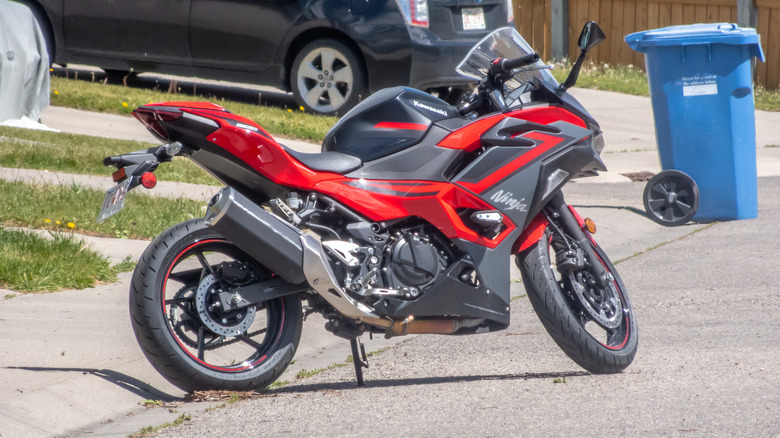Kawasaki Ninja 500 Vs. 650: What's The Difference Between These Motorcycles?
When it comes to fast bikes, you can never go wrong with the Ninja line. Kawasaki has spent decades perfecting these motorcycles, and while they may not reach the speed of a 1,200-plus horsepower Top Fuel Harley, they still deliver a punch that can make anyone's jaw drop. Like with many high-end vehicle lines, the Kawasaki Ninja has a variety of machines meant to cater to almost every type of rider. From the Ninja 250, perfect for starters, to the H2R, meant for those who eat speed for breakfast, lunch, and dinner, there's everything you could want from this one manufacturer. However, in most communities, such a massive catalog comes with favorites. Here, we have the Ninja 650 and 500, two bikes that differ in many ways yet still deliver the same outstanding performance that many have come to expect from Kawasaki.
One of the main differences between these two bikes lies in their engines and the power they deliver. The two have different stylings, which is definitely what will catch your eye first. However, once you're on the road, the difference in engines becomes apparent. The base Kawasaki Ninja 650 features a 649cc, 4-stroke, 8-valve, liquid-cooled engine rated at 67 horsepower and 48.5 pound-feet of torque. On the other hand, the base Ninja 500 comes with a 451cc 4-stroke, liquid-cooled motor worth 51 horsepower and 31.7 pound-feet of torque. Let's take a deeper look at these two bikes to see how they match up against each other.
The differences go well beyond the engine
While we're still on these bikes' engines, it's crucial to mention that the Ninja 650 has larger bore and stroke dimensions at 83.0 by 60.0 millimeters compared to the 500's 70.0 by 58.6. The compression ratio also differs, with the 650's coming in at 10.8:1, which is lower than the 500's 11.3:1. Interestingly enough, both bikes come with the same 6-speed transmission. However, the Ninja 650 features Kawasaki Traction Control electronic rider aid, while the Ninja 500 has the Economical Riding Indicator. Both bikes come with an Anti-lock Brake System (ABS).
As for technology, the Ninja 650 features more engine management tech, including dual throttle valves, assist and super clutch, economical riding indicator, and traction control. The 500 only comes with the assist and super clutch, an economical riding indicator, and smartphone connectivity. The Ergo-fit chassis management system comes standard on both. The differences in these bikes contribute to their unique character. They also influence their price variations and determine their intended use.
One's perfect for daily commutes, while the other is a great entry point
Let's start with the base price of the Ninja 650. Kawasaki has set the MSRP at $7,399 for the non-ABS variant and $7,999 for the ABS model. The Ninja 500 also comes in ABS and non-ABS versions. For the ABS variant, the MSRP falls between $5,699 and $5,899, while the non-ABS version is priced at $5,299. As for use, the 650 is perfect for riders who are comfortable with a Ninja but are looking for a daily commuter, while the 500 is excellent for riders who are still getting acquainted with the Ninja line, thanks to its ease of maneuverability.
Both these bikes offer a great steppingstone to understanding what the Kawasaki Ninjas are all about. Once you can stomach the raw power these beasts embody, you might just be ready to see what the likes of the Ninja H2, rated at 239.6 horsepower and 104.9 pound-feet of torque, and the Ninja H2R, capable of generating 321.5 horsepower and 121.5 pound-feet of torque, are capable of.


